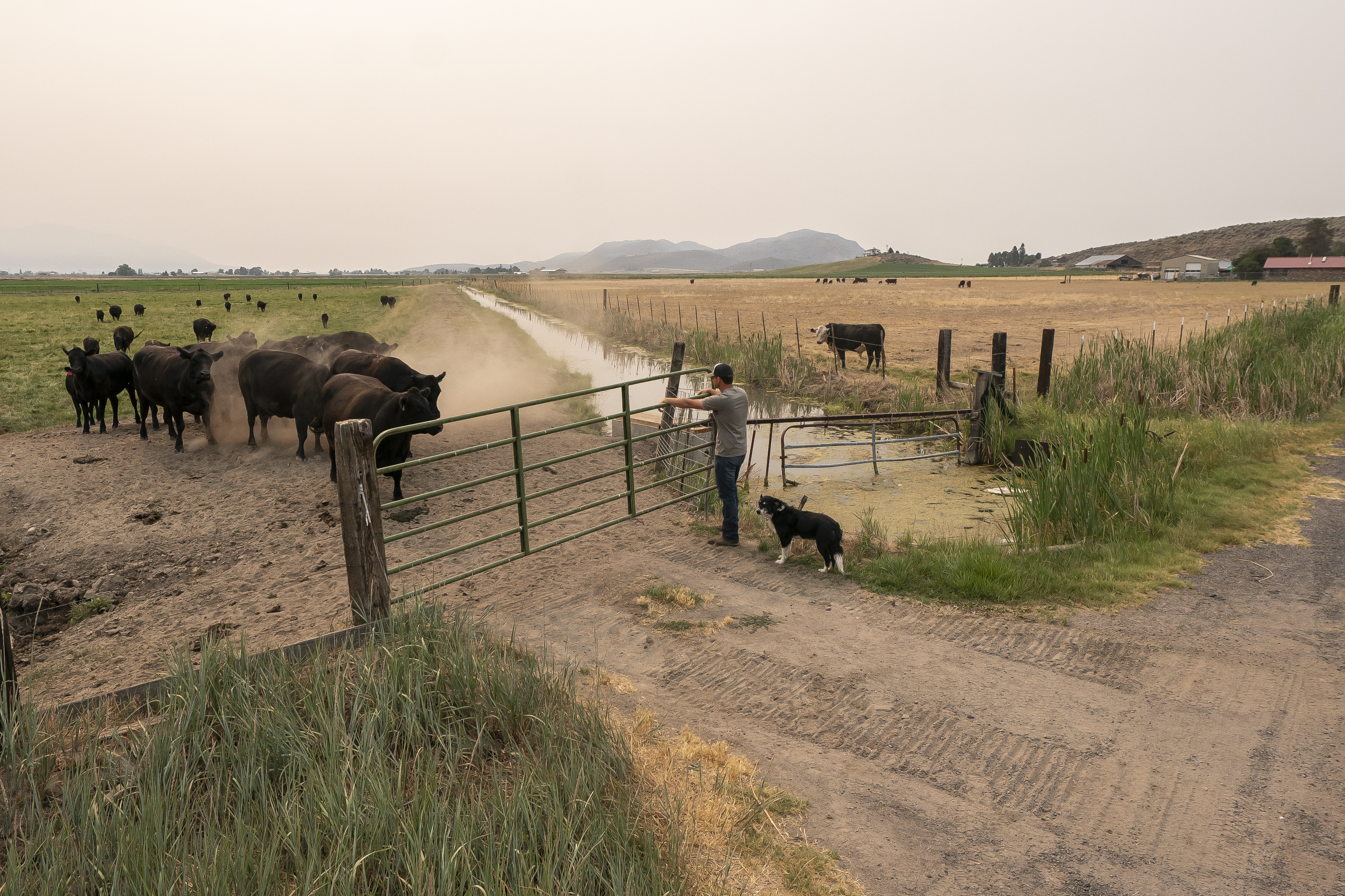
FILE: Justin Grant prepares to move his cattle from a dry grazing field, July 24, 2021, in Klamath Falls, Ore. Drought is forcing water restrictions in the Klamath Basin.
Nathan Howard / AP
Farms that rely on irrigation from a depleted, federally managed lake on the California-Oregon border, along with a Native American tribe fighting to protect fragile salmon, will both receive extremely limited amounts of water this summer as a historic drought and record-low reservoir levels drag on in the U.S. West.
More than 1,000 farmers and ranchers who draw water from the Klamath River that flows from the Upper Klamath Lake to the Pacific Ocean will have access to roughly one-seventh the amount they could get in a wetter year, a federal agency announced Monday. Downstream salmon will receive about half the water they’d get if the reservoir was full.
It’s the third year in a row that severe drought has impacted farmers, fish and tribes in a region where there’s not enough water to satisfy competing demands. Last year, no water at all flowed through the Klamath Reclamation Project’s main irrigation canal, and thousands of downstream juvenile salmon died without reservoir releases to support the Klamath River’s health.
The U.S. Bureau of Reclamation, which manages the irrigation project, announced $15 million in relief for affected farmers and $5 million for Native American tribes as a result of its decision and warned farmers not to take water beyond what was ordered or risk further irrigation reductions and legal action. The agency decides the allocations each year, taking into account court rulings that require certain lake levels to support two federally endangered fish species.
Across the American West, a 22-year megadrought deepened so much last year that the region is now in the driest spell in at least 1,200 years — a worst-case climate change scenario playing out in real time, a study found last month.
Inflow to the Upper Klamath Lake is at a record lows, water managers said, and water allocations could drop further if drought conditions worsen this summer.
“We wish we had better news today. Obviously there are no winners in this critical year as all interests are suffering — fisheries, farmers tribes and waterfowl alike — but given the current hydrology that we have to work with, we did the best job we could,” said Ernest Conant, the bureau’s regional director.
Irrigators reacted with shock and anger to the news and said they weren’t sure they could survive another growing season without adequate water supplies. The amount of water available is less than 15% of what the farmers need, said Ben DuVal, president of the Klamath Water Users Association, who operates a farm in Tulelake, California.
“We have 170,000 acres that could be irrigated this year, and we’re ready to get to work,” he said. “On a single acre, we can produce over 50,000 pounds of potatoes, or 6,000 pounds of wheat. This year, most of that land will not produce any food because the government is denying water for irrigation.”
Klamath River water that is dammed in the Upper Klamath Lake is the linchpin of the nearly 200,000-acre Klamath Reclamation Project, a major agricultural powerhouse of more than 1,000 farms and ranches. Today, farmers there grow everything from mint to alfalfa to potatoes that go to In ‘N Out Burger, Frito-Lay and Kettle Foods.
But the reservoir water is also source of conflict among competing demands, and amid historic drought in the carefully managed river basin there hasn’t been enough water to go around in recent years. Before 2020, the last time water allocations reached such a boiling point in the Klamath Basin was in 2001, when the U.S. government sent federal marshals to the area during a drought year and farmers threatened to breach the head gates.
Under the law, the lake’s water must be kept at a certain level to protect its sucker fish, a key species to the heritage of the Klamath Tribes in southern Oregon. This year’s water decision order irrigators to keep the lake’s water above a certain level for sucker fish spawning in April and May and then at a different level for the remainder of the summer — but even at those levels, the lake will not meet federally mandated minimums for the spring months.
Farmers can start drawing the limited water on Friday.
But federally threatened coho salmon that live in the lower Klamath River, below the reservoir, also need pulses of water from the lake to keep at bay a deadly parasite that thrives in warm and slow-moving water. The salmon are revered by the Yurok Tribe, California’s second-largest Native American tribe.
One so-called “flushing flow” of water that’s about half the normal amount — and half what farmers will get — will be released Friday also.
Yurok Vice Chairman Frankie Myers said the fact that salmon, sucker fish and waterfowl are competing for the region’s water was a “direct sign of the ecological collapse brought by water withdrawals.” He said the Yurok would never stop working to save the salmon.
“Although we are gratified that the river is afforded minimal protections under this plan, it is no time for celebration. Salmon runs will continue to suffer under these conditions, and as climate change intensifies, such protections will become increasingly important,” Myers said.
The slashed water allocations to the Klamath Reclamation Project also will impact two national wildlife refuges in the region that are replenished with irrigation runoff. The refuges host tens of thousands of migratory birds along the Pacific Flyway. Last year, environmentalists and farmers used pumps to combine water from two stagnant wetlands into one deeper one to prevent another outbreak of avian botulism like the one that killed 50,000 ducks in 2020.
Hundreds of domestic wells impacted by the increased groundwater pumping have also gone dry since late last summer.

